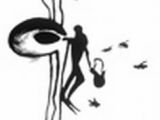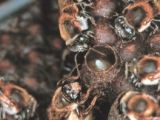One honey bee hive may harbor between 40,000 and 70,000 individuals, equipped with a venomous sting, but this has never stopped animals or humans from being lured to the flavored sweet of the bees.
Monkeys and apes, in the wild, are attracted by honey, so we can presume this is an aliment for the human species since before its evolution from apes.
Cave paintings dated 15,000 years old found in South Africa and India depict honey hunting by Paleolithic people. In Cava D'Arana, discovered in 1919 in Valencia region (Spain), there is a special scene of prehistoric honey hunt, 9,000 years old. (image center above) From a steep cliff, some kind of aerial roots or vine stems hang over. A man is clambering them, and another has already reached the honey bee hive, hidden in a rock bay. The angry bees are already swarming around the brave hunter.
And cave paintings dated 13,000 years old already present beekeeping.
In Turkey, near the locality of Cital-Guyuk, the ruins of a 7,000 years old settlement were found.
On the house's walls some frescos were found, showing scenes from the life of the bees.
But apiculture is not practiced by all populations in the world, and many actual human populations, which are still in the stage of hunter-gatherers, collect the honey of the wild bees.
In Andaman Islands, in southeast Asia, live the Onge pygmies (also named negritos) (photo center).
Today less than 100 still live on the Little Andaman Island.
This semi-nomadic tribe is fully dependent of hunting and gathering. When men, women or children of these tribe, agile climbers, clamber a tree to collect fruits, they often find wild bee hives. At that moment, the gatherer makes a sign on the tree trunk or a stone nearby, a sign which is particular. From that moment, the hive is considered his property, and nobody has the right to touch it, as s/he will receive a harsh punishment.
Even if naked and unprotected by anything against bees' pricks, these will never attack. Chased away from their honeycombs, the bees let the hive on the hunter's charge.
In fact, the scene depicted on the Spanish cave can still be seen even today in Himalaya, South Africa, Southeast Asia and south Arabia.
Let's see, for instance, how such a hunt takes place in Himalaya (photo above). Here, wild bees make hives in the steepest zones of the rocks, which are accessible, maybe, only to birds.
But precisely these hives are those that most attract the honey hunters.
Only the most agile men will employ on honey hunting. They use bamboo stairs, sufficiently resistant and supple, to descend sometimes till 80 m (250 feet) and hanging over the abyss, and they search to get closer to the hive. These people use smoke to chase away the bees. Moss and grass locks are fired and approached to the hives. Once the bees are away, the men cut the honeycombs and put them in wooden pots, attached by a rope.
Many indigenous tribes in tropical Americas still live a life of hunters-gatherers, like Guarani. South American bees have a particularity: they do not possess a sting, but they bite. The Guarani people use both the honey and the wax.
Wax is mostly used for polishing their bows, arrows and spears or for making "cauldrons" to transporting and keep the honey.
The cauldrons are made from a mix of wax and clay. After being well dried (not burnt), they are put at a low fire in which the combs are melted, getting out the honey.
Ropes made from vegetal fibers are also waxed, as the fibers used for making the baskets in which honey is kept, harden this way.
It's worth mentioning that the only native American bees that entered in apiculture, before the European colonization of the Americas, were some stingless bees, grown by the Mayan tribes just for honey (photo center bellow). Maya people even venerated a bee-god, named Ah Muzen Cab.
Australian Aborigines and African tribes also hunt for stingless bee honey.
In Americas, Australia and New Zealand, common honey bees were introduced by Europeans, while they are native in Europe, Asia and Africa (African aggressive varieties are the so-called "killer bees").
In Africa, the honey hunters are helped by a bird, called honeyguide. These birds are related to the woodpeckers, and only three species out of seventeen "guide" for honey.
First, the bird detects the location of a hive by spying the worker bees.
When the bird finds a man, she starts producing some powerful and repeated calls, indicating the hive direction.
While flying from one tree to another, the bird looks back, to convince itself that the man follows its indications.
Local traditions forbid any harm to be done to this bird and even oblige its feeding with wax.
When the hive indicated by the bird is collected, a part of the honeycombs are left untouched near the hive. Even if the bird is named honeyguide, it actually feeds with wax.
But the honeyguide does not guide only people, and not only people follow its indications. Baboons and chimpanzees also use the bird, which could make us suppose that our remote ancestors also were implied this symbiosis.
In fact, the birds have the oldest links not with the primates, but with the ?Honey Badger! (photo bellow, badger and bird in action).
People in some African tribes even imitate the grunts of the badger, which attract the bird?

 14 DAY TRIAL //
14 DAY TRIAL // 



